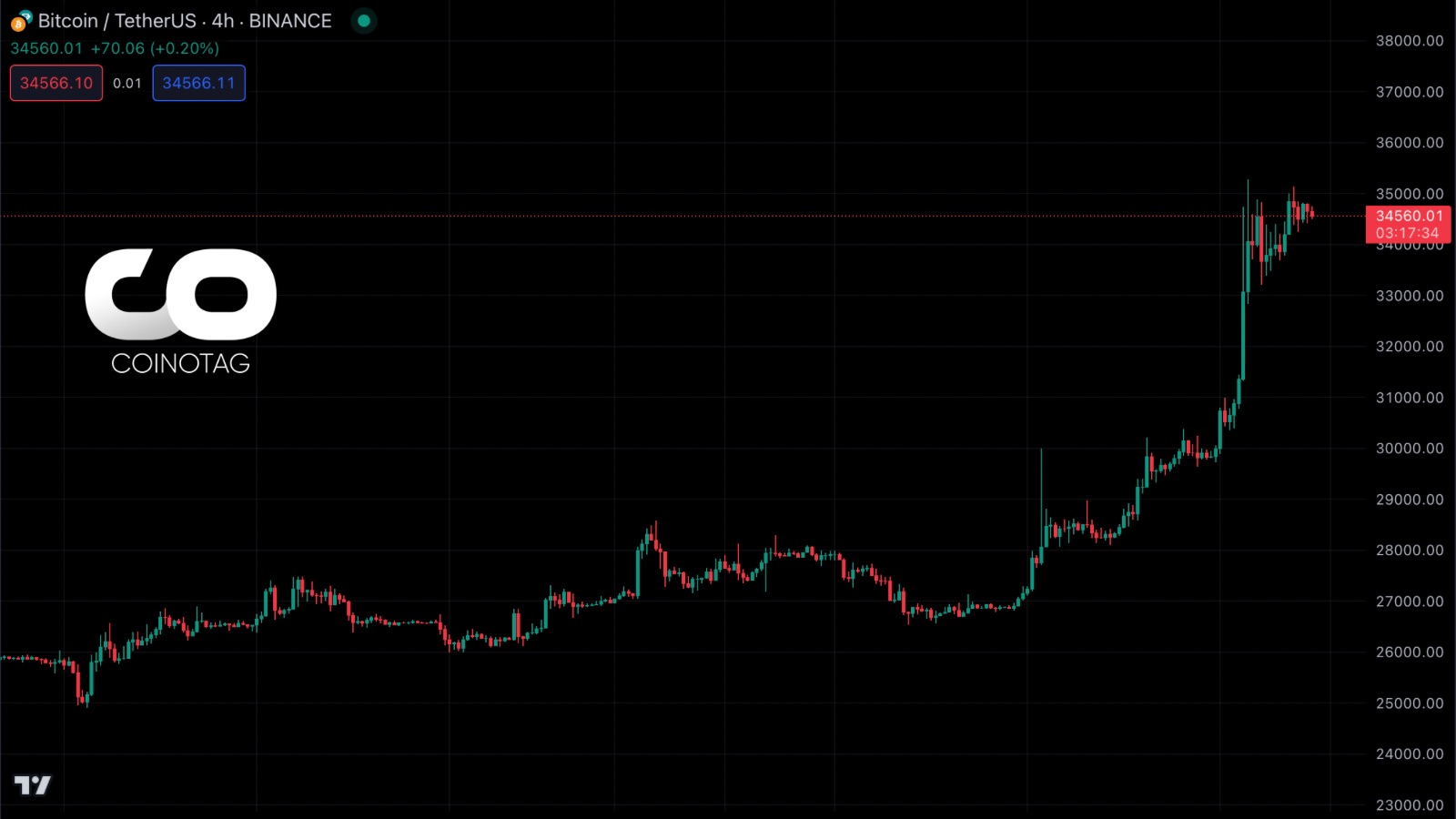| COINOTAG recommends • Exchange signup |
| 💹 Trade with pro tools |
| Fast execution, robust charts, clean risk controls. |
| 👉 Open account → |
| COINOTAG recommends • Exchange signup |
| 🚀 Smooth orders, clear control |
| Advanced order types and market depth in one view. |
| 👉 Create account → |
| COINOTAG recommends • Exchange signup |
| 📈 Clarity in volatile markets |
| Plan entries & exits, manage positions with discipline. |
| 👉 Sign up → |
| COINOTAG recommends • Exchange signup |
| ⚡ Speed, depth, reliability |
| Execute confidently when timing matters. |
| 👉 Open account → |
| COINOTAG recommends • Exchange signup |
| 🧭 A focused workflow for traders |
| Alerts, watchlists, and a repeatable process. |
| 👉 Get started → |
| COINOTAG recommends • Exchange signup |
| ✅ Data‑driven decisions |
| Focus on process—not noise. |
| 👉 Sign up → |
- Bitcoin’s market dominance soars to 54%, marking its highest in the last 2.5 years.
- The upcoming halving event in April 2024 is eyed as a potential bullish catalyst.
- Historically, October’s performance strengthens Bitcoin’s position in the crypto market.
Exploring Bitcoin’s impressive market dominance as it approaches the much-anticipated halving event in 2024, and analyzing historical data for insights on its potential impact.
Bitcoin Dominance Peaks: What’s Behind the Surge?
Bitcoin’s market dominance—a crucial metric that measures Bitcoin’s market capitalization relative to the entire cryptocurrency market—has climbed to an impressive 54%. This remarkable feat, not seen in the last 30 months, is a testament to Bitcoin’s strengthening position in the crypto space. This growth comes just ahead of the eagerly awaited Bitcoin halving event slated for April 2024.
Halving Anticipation: A Potential Price Catalyst
The Bitcoin halving event, which occurs every four years, is a mechanism where the mining reward per block is reduced by half. This inherently slashes the supply of the crypto asset amid its escalating demand, often setting the stage for bullish price action. The forthcoming halving will reduce the BTC mining reward from a current 6.25 BTC to 3.125 BTC. Given that the total Bitcoin supply is capped at 21 million, the event promises to create a pronounced supply-demand gap, further restricting the flow of new BTC into circulation.
Historical Perspective: Bitcoin’s Dominance Trajectory

| COINOTAG recommends • Professional traders group |
| 💎 Join a professional trading community |
| Work with senior traders, research‑backed setups, and risk‑first frameworks. |
| 👉 Join the group → |
| COINOTAG recommends • Professional traders group |
| 📊 Transparent performance, real process |
| Spot strategies with documented months of triple‑digit runs during strong trends; futures plans use defined R:R and sizing. |
| 👉 Get access → |
| COINOTAG recommends • Professional traders group |
| 🧭 Research → Plan → Execute |
| Daily levels, watchlists, and post‑trade reviews to build consistency. |
| 👉 Join now → |
| COINOTAG recommends • Professional traders group |
| 🛡️ Risk comes first |
| Sizing methods, invalidation rules, and R‑multiples baked into every plan. |
| 👉 Start today → |
| COINOTAG recommends • Professional traders group |
| 🧠 Learn the “why” behind each trade |
| Live breakdowns, playbooks, and framework‑first education. |
| 👉 Join the group → |
| COINOTAG recommends • Professional traders group |
| 🚀 Insider • APEX • INNER CIRCLE |
| Choose the depth you need—tools, coaching, and member rooms. |
| 👉 Explore tiers → |
Bitcoin’s market dominance began its ascent at the beginning of October, climbing from slightly under 49% to achieve this 2.5-year record. October has often been tagged as a bullish month for cryptocurrencies, earning it the epithet “Uptober.” This bullish sentiment was further corroborated by Bitcoin’s remarkable price appreciation over recent weeks, catapulting from just below $27,000 at October’s start to touching a yearly apex at $35,000. Contrastingly, in 2017, Bitcoin effortlessly maintained a market dominance exceeding 80%, with Ethereum trailing at 10%–17%. However, the intervening years witnessed a gradual erosion of Bitcoin’s dominance, attributed to the proliferation of other cryptocurrencies and the exponential growth of several new tokens in the 2021 bull market.
Conclusion
Bitcoin’s surging market dominance coupled with the looming halving event suggests a potentially bullish horizon for the premier cryptocurrency. While the dynamics of the crypto market remain inherently volatile and influenced by myriad factors, historical data, and current indicators suggest a strong position for Bitcoin in the near term. However, as with all investments, a blend of diligent research and cautious optimism is essential.
| COINOTAG recommends • Exchange signup |
| 📈 Clear interface, precise orders |
| Sharp entries & exits with actionable alerts. |
| 👉 Create free account → |
| COINOTAG recommends • Exchange signup |
| 🧠 Smarter tools. Better decisions. |
| Depth analytics and risk features in one view. |
| 👉 Sign up → |
| COINOTAG recommends • Exchange signup |
| 🎯 Take control of entries & exits |
| Set alerts, define stops, execute consistently. |
| 👉 Open account → |
| COINOTAG recommends • Exchange signup |
| 🛠️ From idea to execution |
| Turn setups into plans with practical order types. |
| 👉 Join now → |
| COINOTAG recommends • Exchange signup |
| 📋 Trade your plan |
| Watchlists and routing that support focus. |
| 👉 Get started → |
| COINOTAG recommends • Exchange signup |
| 📊 Precision without the noise |
| Data‑first workflows for active traders. |
| 👉 Sign up → |
| COINOTAG recommends • Members‑only research |
| 📌 Curated setups, clearly explained |
| Entry, invalidation, targets, and R:R defined before execution. |
| 👉 Get access → |
| COINOTAG recommends • Members‑only research |
| 🧠 Data‑led decision making |
| Technical + flow + context synthesized into actionable plans. |
| 👉 Join now → |
| COINOTAG recommends • Members‑only research |
| 🧱 Consistency over hype |
| Repeatable rules, realistic expectations, and a calmer mindset. |
| 👉 Get access → |
| COINOTAG recommends • Members‑only research |
| 🕒 Patience is an edge |
| Wait for confirmation and manage risk with checklists. |
| 👉 Join now → |
| COINOTAG recommends • Members‑only research |
| 💼 Professional mentorship |
| Guidance from seasoned traders and structured feedback loops. |
| 👉 Get access → |
| COINOTAG recommends • Members‑only research |
| 🧮 Track • Review • Improve |
| Documented PnL tracking and post‑mortems to accelerate learning. |
| 👉 Join now → |








